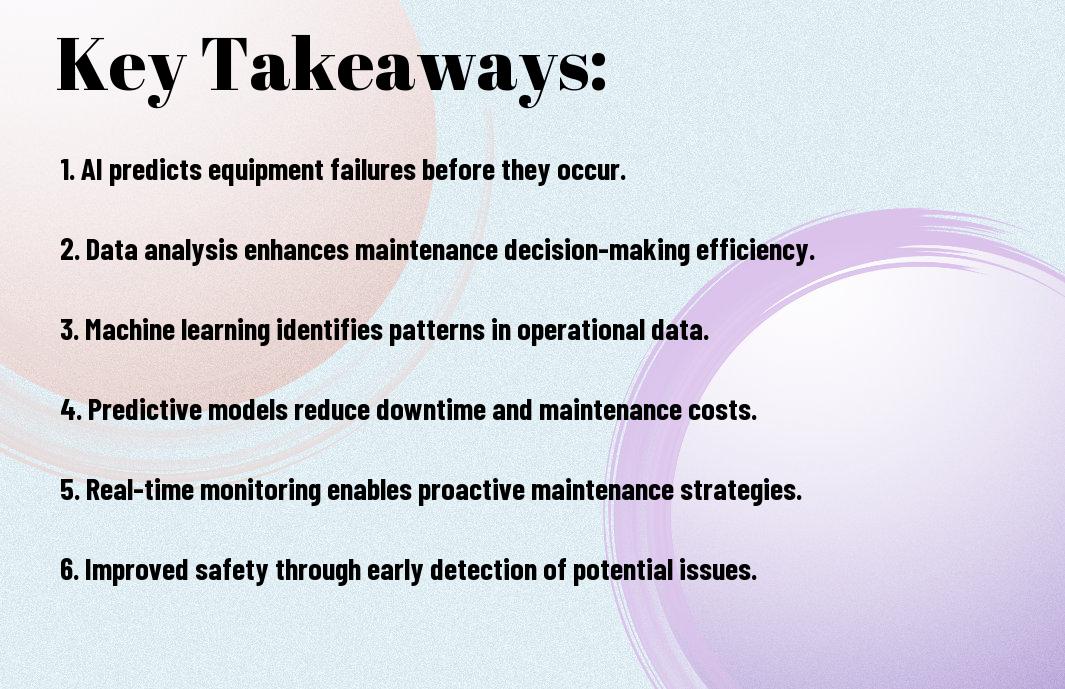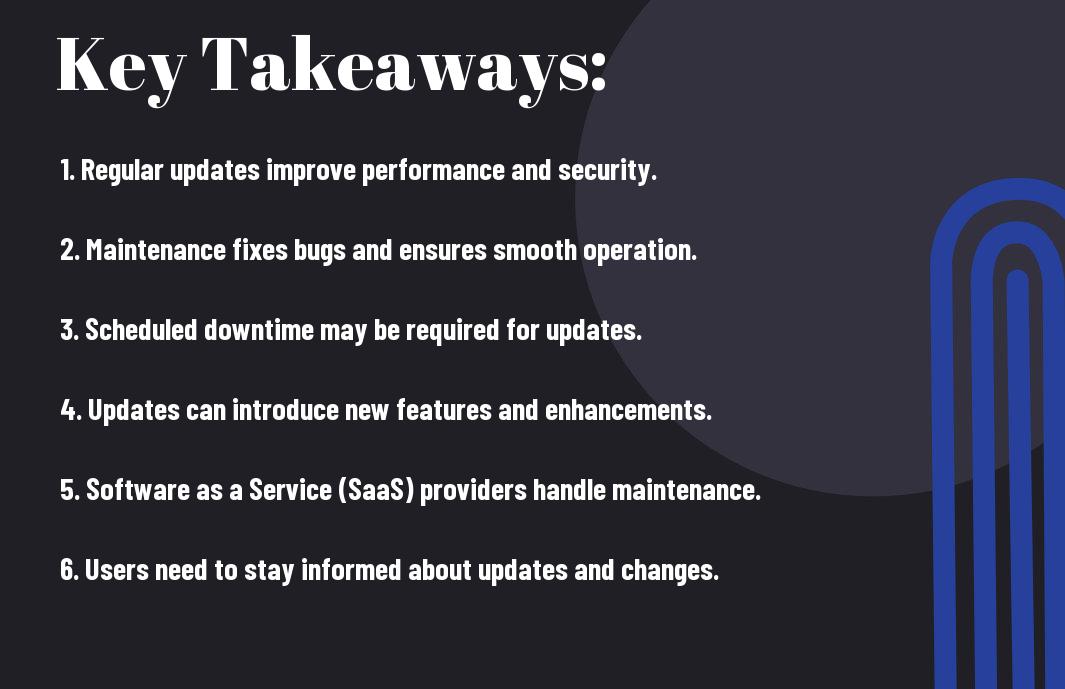You are likely aware of the benefits of predictive maintenance in reducing equipment downtime and increasing overall efficiency. As you explore ways to optimize your maintenance strategy, you can leverage AI agents to take it to the next level. By utilizing AI-powered predictive maintenance, you can significantly reduce downtime and costs. For a deeper explore this topic, check out AI Agents in Predictive Maintenance: Reducing Downtime and Costs to learn more about how your business can benefit from this innovative approach.
Key Takeaways:
- Artificial Intelligence agents are being utilized to power Predictive Maintenance by analyzing large amounts of data from various sources, such as sensors and machines, to identify potential issues before they occur.
- The use of Machine Learning algorithms enables AI agents to learn from experience and improve their ability to detect patterns and anomalies, leading to more accurate Predictions and reduced downtime.
- By leveraging Real-Time Data and Analytics, AI agents can provide insights that help maintenance teams prioritize and schedule maintenance activities more effectively, resulting in increased Efficiency and reduced costs.
Fundamentals of Predictive Maintenance
Before plunging into the world of AI-powered predictive maintenance, you need to understand the basics. Predictive maintenance is a strategy that uses data and analytics to predict when equipment is likely to fail, allowing you to take proactive measures to prevent downtime and reduce maintenance costs.
Principles of Predictive Maintenance
Across various industries, you will find that predictive maintenance is based on the principle of using real-time data to identify potential equipment failures. You can use sensors, algorithms, and other tools to collect and analyze data, enabling you to make informed decisions about maintenance schedules.
Role of AI in Predictive Maintenance
Maintenance operations are being revolutionized by AI, and you are at the forefront of this change. AI-powered predictive maintenance enables you to analyze vast amounts of data, identify patterns, and make predictions about equipment failures, allowing you to take proactive measures to prevent downtime.
A significant advantage of AI in predictive maintenance is that it enables you to automate many tasks, freeing up your time to focus on more strategic activities. You can use AI algorithms to analyze data from sensors, machines, and other sources, and then use this information to predict when maintenance is required, reducing the risk of equipment failure and minimizing downtime. As you explore the role of AI in predictive maintenance, you will discover that it has the potential to transform your maintenance operations, making them more efficient, effective, and reliable.
AI Technologies in Predictive Maintenance
It is imperative to understand the role of AI technologies in predictive maintenance, as you explore the various tools and techniques that enable proactive maintenance strategies, allowing you to optimize your operations and reduce downtime.
Machine Learning Algorithms
For instance, you can leverage machine learning algorithms to analyze data from your equipment and identify patterns that indicate potential failures, enabling you to take corrective action before issues arise, and improving your overall maintenance efficiency.
Internet of Things (IoT) Integration
Behind the success of predictive maintenance lies the effective integration of IoT devices, which provide you with real-time data and insights, allowing you to monitor your equipment’s performance and make informed decisions about maintenance and repairs.
Learning from the data generated by IoT devices, you can refine your predictive maintenance strategy, identifying areas of improvement and optimizing your operations to achieve greater efficiency, reliability, and cost savings, ultimately enhancing your overall maintenance outcomes.
Data Analysis and Processing
Keep in mind that effective data analysis and processing are vital for predictive maintenance. You will need to harness the power of AI agents to analyze and process large amounts of data from various sources, including sensors, machines, and other equipment. This enables you to identify potential issues before they become major problems, allowing for proactive maintenance and minimizing downtime.
Data Collection and Preprocessing
Along with the increasing amount of data being generated, you will need to ensure that it is collected and preprocessed efficiently. This involves cleaning, transforming, and formatting the data into a usable format for analysis, enabling you to make informed decisions about your maintenance needs.
Pattern Recognition and Anomaly Detection
On the path to predictive maintenance, you will utilize AI agents to recognize patterns and detect anomalies in your data. This allows you to identify potential issues before they occur, enabling prompt action to prevent equipment failure and reduce maintenance costs.
Pattern recognition is a key aspect of predictive maintenance, as it enables you to identify normal operating conditions and detect deviations from these norms. You can then use this information to adjust your maintenance schedule, replace worn-out parts, and optimize your equipment’s performance, ultimately leading to increased efficiency and reduced downtime.
Implementation and Integration
Unlike traditional maintenance approaches, implementing AI-powered predictive maintenance requires a strategic plan, and you’ll need to consider your existing infrastructure and resources to ensure a seamless integration.
System Design and Architecture
Around the time you start designing your system, you’ll want to consider a modular architecture that allows for easy scalability and flexibility, enabling you to adapt to your evolving needs and incorporate new technologies as they emerge, making your predictive maintenance strategy more effective.
Real-time Monitoring and Response
With the ability to monitor your equipment in real-time, you can quickly identify potential issues and take proactive measures to prevent downtime, and your AI agent will be able to analyze data from various sources to provide you with actionable insights.
Even as you navigate the complexities of real-time monitoring, you’ll find that your AI agent is capable of analyzing vast amounts of data, detecting anomalies, and alerting you to potential issues before they become major problems, allowing you to take swift action and minimize the impact on your operations, and as a result, you’ll be able to optimize your maintenance schedule and reduce costs.
Benefits and Challenges
Now that you’re exploring the potential of AI agents in predictive maintenance, it’s important to consider the advantages and disadvantages of implementing this technology in your operations.
Increased Efficiency and Reliability
Effectively, you can improve your maintenance processes by leveraging AI agents to analyze data and predict potential equipment failures, allowing you to take proactive measures to prevent downtime and increase overall efficiency.
Overcoming Technical and Organizational Hurdles
Fortunately, you can overcome the obstacles associated with integrating AI agents into your maintenance routine by assessing your current infrastructure and identifying areas where AI can be effectively applied to support your goals.
Consequently, as you work to overcome these technical and organizational hurdles, you will need to consider factors such as data quality, compatibility with existing systems, and the potential need for additional training or resources to ensure a seamless integration of AI agents into your predictive maintenance strategy, allowing you to maximize the benefits and minimize disruptions to your operations.

Future Directions
Your organization can leverage AI agents for predictive maintenance, transforming your operations and enhancing efficiency.
Advancements in AI and IoT
Beneath the surface of current technologies, you’ll find emerging advancements in AI and IoT that will further enhance predictive maintenance capabilities, offering you more precise insights.
Potential Applications Beyond Maintenance
Opposite to traditional views, you’ll discover that AI agents have potential applications beyond maintenance, such as optimizing production and improving product quality, allowing you to make data-driven decisions.
In fact, as you explore these applications, you’ll find that AI agents can help you identify areas of improvement in your production process, enabling you to streamline operations and reduce costs, ultimately giving you a competitive edge in the market.

To wrap up
With this in mind, you now understand how AI agents are revolutionizing predictive maintenance, enabling your business to stay ahead of equipment failures. You can leverage AI-powered predictive maintenance to optimize your operations, reducing downtime and increasing overall efficiency. By adopting this approach, you will be able to make data-driven decisions, improving your bottom line and gaining a competitive edge in your industry, ultimately transforming your maintenance operations with AI-driven insights.
FAQ
Q: What is predictive maintenance and how do AI agents support it?
A: Predictive maintenance is a proactive approach to maintaining equipment and machinery by using data and analytics to predict when maintenance is required. AI agents power predictive maintenance by analyzing vast amounts of data from sensors, machines, and other sources to identify patterns and anomalies that may indicate potential equipment failures. By leveraging machine learning algorithms and real-time data analysis, AI agents can detect issues before they occur, enabling maintenance teams to take corrective action and prevent downtime.
Q: How do AI agents collect and process data for predictive maintenance?
A: AI agents collect data from various sources, including sensors, IoT devices, and existing maintenance records. This data is then processed using advanced analytics and machine learning algorithms to identify trends, patterns, and correlations that may indicate potential equipment failures. AI agents can also integrate with existing systems, such as CMMS (Computerized Maintenance Management Systems) and ERP (Enterprise Resource Planning) systems, to access additional data and provide a more comprehensive view of equipment performance.
Q: What are the benefits of using AI agents for predictive maintenance?
A: The benefits of using AI agents for predictive maintenance include increased equipment uptime, reduced maintenance costs, and improved overall efficiency. By detecting potential issues before they occur, maintenance teams can schedule maintenance during planned downtime, reducing the likelihood of unexpected failures and associated downtime. Additionally, AI agents can help optimize maintenance schedules, prioritize tasks, and allocate resources more effectively, leading to cost savings and improved productivity.
Q: Can AI agents be used in various industries for predictive maintenance?
A: Yes, AI agents can be used in various industries, including manufacturing, oil and gas, energy, transportation, and healthcare, among others. The application of AI agents for predictive maintenance is industry-agnostic, and their use can be tailored to specific industry needs and requirements. For example, in manufacturing, AI agents can be used to predict equipment failures in production lines, while in healthcare, they can be used to predict medical equipment failures and optimize maintenance schedules.
Q: How do AI agents improve the accuracy of predictive maintenance predictions?
A: AI agents improve the accuracy of predictive maintenance predictions by using advanced machine learning algorithms and real-time data analysis. These algorithms can identify complex patterns and correlations in data that may not be apparent through traditional analysis methods. Additionally, AI agents can learn from experience and adapt to changing equipment performance and operating conditions, continuously improving the accuracy of predictive maintenance predictions over time. This enables maintenance teams to make more informed decisions and take proactive measures to prevent equipment failures.



